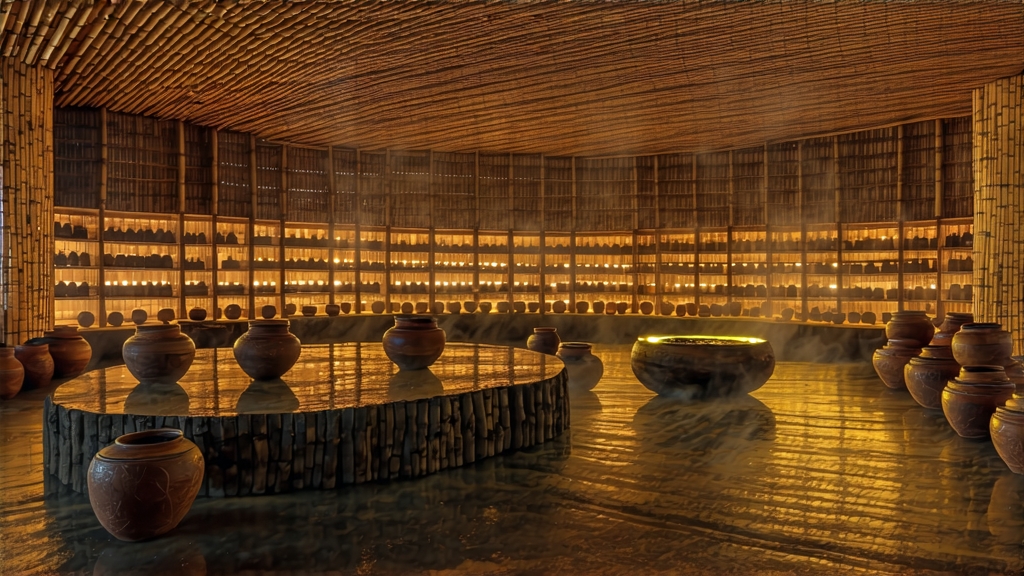
Tucked away in the southern folds of China’s Guangxi Zhuang Autonomous Region, Liu Bao tea has spent four centuries quietly fermenting its way into the hearts of merchants, monks, and modern connoisseurs. To the uninitiated it is merely another dark leaf, yet to those who listen, Liu Bao whispers stories of caravans that once carried it along the 2,000-kilometre Ancient Tea-Horse Road, of riverboats that glided down the Xun Jiang to Hong Kong, and of humid storerooms where the tea absorbed the very soul of the tropics. Today, as specialty cafés from Berlin to Brooklyn scramble to offer “post-fermented” options, Liu Bao stands ready to reveal why Chinese black tea—what the West now calls “dark tea”—was once worth its weight in silver.
Historical Footprints
The name Liu Bao literally means “Six Forts,” a reference to the six defensive garrisons established during the Ming dynasty around the small township of Wuzhou. By the late 1600s the region had become a staging post for Yunnan pu-erh travelling to Guangdong’s Pearl River Delta, but local growers soon discovered that their own large-leaf cultivars—Camellia sinensis var. sinensis, Guangxi strain—responded brilliantly to the double magic of sun-withering and humid storage. Qing-era tax records list Liu Bao as a “medicinal tribute,” prescribed for cooling blood and easing digestion among palace officials suffering from rich Cantonese cuisine. When British and Dutch clipper ships arrived in the 19th century, Liu Bao was already waiting on the docks, pressed into 37-kilogram bamboo baskets lined with banana leaf, ready to sail for Southeast Asia where labourers swore it prevented beriberi and cured opium hangovers.
From One Leaf, Many Styles
Modern Liu Bao is classified by both leaf grade and aging protocol. The top tier, “Special Flagship,” uses only the first two leaves and a bud picked before Qingming festival; the pluck is so tender that the finished tea still shows tiny silver tips after repeated steamings. At the opposite end, “Worker Grade” incorporates the fourth and fifth leaves, prized by Malaysian tin miners for its strong, oily body and low price. Between these extremes lie “First Grade,” “Second Grade,” and “Broken Liu Bao,” each sorted by mechanical sieves and then channelled into one of three aging paths: traditional bamboo-basket humid storage, modern climate-controlled cellars, or the increasingly fashionable “dry-cave” method that mimics the natural limestone caverns of Wuzhou. The result is a matrix of at least fifteen commercial designations, yet every authentic Liu Bao shares two genetic markers: a camphor-betel nut top note and a lingering rock-sweet finish that Chinese tasters liken to “sugarcane growing on limestone.”
Crafting the Darkness
Unlike pu-erh, which can be sheng (raw) or shou (wet-piled), Liu Bao is always post-fermented, but the Guangxi technique predates Yunnan’s shou process by at least a century. Fresh leaves are first withered under subtropical sun for four to six hours, achieving 65 % moisture loss while developing a light grassy fragrance. They are then pan-fired at 280 °C for exactly 90 seconds—long enough to kill green enzymes yet short enough to preserve leaf integrity. The critical step is “re-steaming and soft-pressing”: the semi-dry leaves are steamed for three minutes, packed into 40-kilogram banana-leaf bundles, and stacked in pairs inside sealed bamboo baskets. Here the magic begins: indigenous microbes—primarily Aspergillus niger, Blastobotrys adeninivorans, and a local strain of Bacillus subtilis—thrive in the 28–32 °C, 85 % humidity environment created by the decomposing banana leaf. Over the next 45–60 days the pile is turned only twice, allowing the core temperature to rise to 55 °C, a gentler curve than pu-erh’s 65 °C. The slower thermal climb encourages the formation of unique aminobutyric acids, believed to be responsible for Liu Bao’s famous “cooling” effect on the body. After piling, the tea is sun-dried again, then transferred to limestone caves or modern humidity rooms for a minimum of three years before market release. Veteran collectors seek lots aged fifteen years or more, during which time